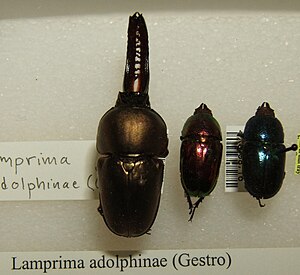Lamprima adolphinae
| Lamprima adolphinae | ||||||||||||
|---|---|---|---|---|---|---|---|---|---|---|---|---|

Lamprima adolphinae |
||||||||||||
| Systematics | ||||||||||||
|
||||||||||||
| Scientific name | ||||||||||||
| Lamprima adolphinae | ||||||||||||
| ( Gestro , 1875) |
Lamprima adolphinae is a beetle (Coleoptera) fromthe Schröter family (Lucanidae).
distribution
Lamprima adolphinae is endemic to New Guinea . The species is said to occur in Japan as a neozoon.
features
The species is characterized by a very pronounced sexual dimorphism . The males can reach a body length of 27 millimeters, the females are much smaller and are up to 22 millimeters long. The pronotum and elytra are colored metallic green, the head and abdomen are coppery reddish. The pronotum is wider than it is long and reaches the width of the elytra. In the male, the body surface is smooth and shiny, it has a sparse, inconspicuous puncture. The mandibles are noticeably elongated on the head and protrude forward. They are black in color, slightly curved upwards, toothed on the inside and taper off in three points (there are also rarely males with imperforate mandibles). The tip of the anterior tibia has a noticeably enlarged, red-colored spur that is triangularly widened towards the front. The females are more dull due to stronger puncturing, the special formations of the males (mandibles, spurs) are not developed.
On microscopic examination there is a very short, curved hair (seta) with a pore near the base in each pore of the elytra; the shape is characteristic of the subfamily.
Lamprima adolphinae comes in many different colors , especially in bred animals. There are cultivated forms in blue, red, black and other colors.
Way of life
The animals feed on tree sap and overripe fruit. The females lay the eggs in rotten logs. To do this, they create corridors in the dead wood. The larvae live and feed on rotten hardwood. Depending on the temperature and the food available, they take 9 to 13 months to develop. The male larvae can reach a length of up to 60 millimeters, the female larvae up to 40 millimeters.
breed
Lamprima adolphinae is common in many breeds. This is due on the one hand to the beauty of the species and on the other hand to the ease of breeding. Breeding of the species is considered easy under favorable conditions. To do this, the breeding container should be kept moist. Furthermore, there must be enough rotten wood for lavas and egg-laying, as well as food for the beetles. The female beetle lays the eggs in rotten pieces of wood after mating. These should not be too soft, otherwise the female will not be able to drill corridors. After the eggs are laid, the female closes each passage, which ends up with one or more eggs. The larvae feed on rotten wood. After about a year the larva is fully grown and ready to pupate. The finished beetles hatch after about two more months.
Systematics
For the species Gestro described a new genus Neolamprima in the first description , later this was synonymous with Lamprima and the species was transferred to the genus Lamprima . A number of subspecies have been described, which today are mostly no longer considered justified.
The species belongs to the subfamily Lampriminae , which comprises only about 10 to 20 species and is distributed exclusively in the southern hemisphere.This subfamily occurs with four genera in Australia, New Zealand, New Guinea and the surrounding islands and with one genus in South America. The genus Lamprima consists of five species. Lamprima adolphinae is the only representative from New Guinea.
Individual evidence
- ↑ Stag beetles of New Guinea
- ↑ Lamprinae adolphinae at Bio-Nica.org
- ↑ Mito Toshizaku, Uesugi Tetsuro: Invasive Alien Species in Japan: The Status Quo and the New Regulation for Prevention of their Adverse Effects. In: Global Environmental Research. Vol. 8 (2004), No. 2, pp. 171-193.
- ↑ Raffaello Gestro: Descrizione di un nuovo di genere e alcune nuove specie di Coleotteri Papuani. In: Annali del Museo Civico di Storia Naturale. Genova 7 (1875), pp. 993-1027. (Full text)
- ^ Gilbert J. Arrow: Horned Beetles. A study of the fantastic in nature. Junk Publishers, The Hague 1951, p. 89.
- ↑ BA Holloway: Elytral surface structures as indicators of relationships in stag beetles, with special reference to the New Zealand species (Coleoptera: Lucanidae). In: New Zealand Journal of Zoology. Vol. 24 (1997), pp. 47-64.
- ^ Wilhelm Nagel: Neolamprima Gestro = Lamprima Latr., Neolamprima mandibularis McLeay = Lamprima Latreillei McLeay (Col. Lucan.). In: Entomological Communications. 11 (1922) (1), pp. 16-17.
- ↑ Dimitry Telnov: Biodiversity, Biogeography and Nature Conservation in Wallacea and New Guinea. Volume 1, Entomological Society of Latvia, Riga 2011, ISBN 978-9984-9768-4-6 .
- ↑ Clarcke H. Scholtz, Vasily V.Grebennikov: Lucanidae Latreille. 1802. In: Rolf G. Beutel, Richard Leschen (Ed.): Handbook of Zoology / Handbuch der Zoologie. Volume 4: Arthropoda. 2nd half: Insecta, Coleoptera, Beetles. Part 38, Volume 1: Morphology and Systematics (Archostemata, Adephaga, Myxophaga, Polyphaga partim). De Gruyter, 2011, ISBN 978-3-11-090455-0 .
- ↑ BA Holloway: Lucanidae. In: Fauna of New Zealand. 61. Manaaki Whenua Press, Lincoln, New Zealand 2007, ISBN 0-478-09395-7 .
Web links
- Lamprima adolphinae on biolib.cz (English)